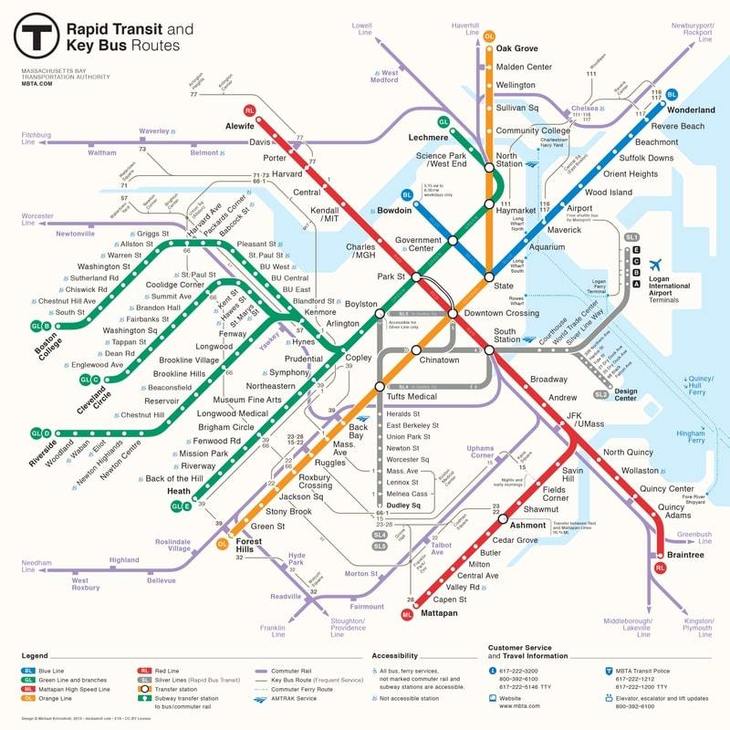
Hailing from Boston, the only subway I had ever really known was the Massachusetts Bay Transport Authority (MBTA), commonly referred to by Bostonians as the 'T'.
I didn't know what to expect from the London Underground, but after riding on the tube for a few months now, I've picked up some major differences between the two.
I decided to evaluate both subway systems, to determine which city has a better overall method of transport. Let the duel commence!
History

Boston's first subway system was opened in 1897, as a method to allow tunnels for streetcars under Tremont Street, where most of the workforce in the city was during the late 19th century. Originally labeled the Metropolitan Transit Authority in 1947, it was later changed to the Massachusetts Bay Transit Authority in 1964, in the process of merging all transit of Eastern Massachusetts into one complete public transit system. The Tremont Street subway is still used today.
The London Underground (as most Londoners will know) was the first subway system in the world — created in 1863, with a line between Paddington (then called Bishop's Road) and Farringdon Street. Still, while Boston's subway was the third in the world, it was the first in North America — and a revolutionary chapter in the USA's history of transport.
Result: It's a draw
Card name

To get around in Boston, you use what is known as a Charlie Card. It's named after the folk song 'Charlie on the MTA,' a song which tells the story of a subway rider named Charlie who was stuck on an endless train ride underneath the streets of Boston because he was unable to pay the exit fare.
When travelling in London, I traded in my Charlie card for an Oyster card. The name 'Oyster' was picked to convey the metaphor that like the mollusk holds a pearl, the card holds the treasure of travel. Other factors like the history of oyster beds along the Thames also played a significant role in deciding on the name over less-inspired other choices like Gem and Pulse. Of course, on the tube, you can pay by contactless too — a boon not afforded to Bostonians.
But we're focussing on the official cards here, and Oyster cards don't have their own song, so...
Winner: Boston
Price

It doesn't matter what zone or what time of day you're travelling to in Boston — it's the same price for a ride (just $2.40 since you're asking). We don't charge a fee for the card either, unlike TfL, who will now keep your £5 Oyster deposit for at least year.
Winner: Boston
Wait times

Anyone living in Boston knows one of the most annoying aspects of the T is its unpredictable nature. You could be waiting anywhere from 10-20 minutes depending on which station you are at. While the underground stations are far more reliable, there are no back-to-back trains within a few minutes of one another.
So, when waiting for trains in London Underground stations, I was delighted to find if I missed one train, I would at most have to wait five minutes for the next one. This certainty of the Underground has made moving around London more convenient and less worrisome for arriving at places on time.
Winner: London
Size

People would be surprised to learn how much of the greater region of Boston the T actually covers. There are a total of 149 stops and 133 stations with four lines: Green line, Red line, Blue line, and the Orange line. Subway lines run through the cities of Cambridge, Newton, Revere, and Quincy. Since you can only refill your card at a physical station, this makes the accessibility for travellers who have not remembered to add funds to their cards quite challenging.
The London Underground subway system serves 270 stations, with 11 lines: Bakerloo, Central, Circle, District, Hammersmith & City, Jubilee, Metropolitan, Northern, Piccadilly, Victoria, Waterloo & City. Since each stop is a station, there are many more opportunities to fill your Oyster card, meaning you can travel almost anywhere without the worry of making sure your card has enough for a fare ahead of time. (Oh yes, you can also top up your credit online in London.)
Winner: London
Line names

In Boston, when referring to your destination, you simply say which line you're hopping on by colour. For instance, my school Boston University runs along the Green line, which is then broken down into sections (B, C, D, or E) depending on which area you are heading to outside the city, with the Green line being the largest.
In London, you would look silly if you were to refer to the Northern as the Black line, or District as the Green line. Instead, you use the actual given line names, depending on which part of London you wish to go to. Being unfamiliar with the system, I felt this has actually made my exploration of the city much easier. Plus, London's line names are more imaginative.
Winner: London
Décor

No one would consider an MBTA station a particular 'tourist attraction' unlike the London Underground. The stations are pretty bland, featuring mostly advertisements from local events and colleges around the city.
When you're inside a London Underground station, a totally different essence is translated to commuters. Advertisements cover the latest movies, travel destinations, and concerts. You can also find artwork featured at tube sites thanks to the Art on the Underground.
Winner: London
Final score
London: 4 Boston: 2. Congrats London!



